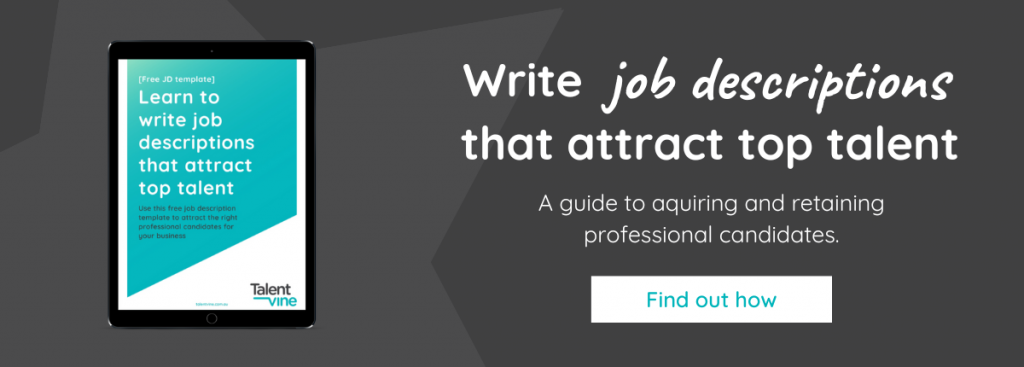Organisations are working harder than ever to make workplaces more inclusive across Australia and the world. Across websites, social media channels, publications, and offices we are seeing a focus on the importance of inclusivity and diversity.
However, an often-overlooked channel of communication is job listings, and they’re one of the most important. For many prospective candidates, it’s their first touchpoint with your organisation. If you’re looking to hire diverse talent, it is essential to have inclusive job descriptions. Not only does it represent your organisation as an employer that values diversity, it also ensures candidates from these backgrounds do not self-select out of applying.
The challenge lies in representing your organisation as an inclusive hirer in a succinct, honest, and convincing way.
Here are a few tips to help you write more inclusive job descriptions, recruit diverse talent and build a more equitable organisation.
Why is Diverse Hiring Important?
In another blog post about inclusive hiring practices, we highlighted that diverse teams are known to be better problem solvers, better able to relate to customers, are more innovative, and more productive in general. However, the benefits don’t just end there.
Organisations should not be excluding anyone from their open positions, and in today’s talent-short market, they cannot afford to. Having a talent pool that is both wide and deep is essential to hiring the right people. Inclusive job descriptions are just that – they make your opening appealing to as many potential applicants as possible.
How to Write Inclusive Job Descriptions
Communicate your values
As an extension of your employer brand, job descriptions also represent your organisation as a whole. Demonstrating that you are an inclusive and diverse organisation helps to place yourself positively in the eye of potential candidates. This should be an honest representation of your organisation and its goals, not simply lip service to try and attract more candidates. People want to work at organisations that reflect their values, and you want to hire people who share your vision. If not, you could be left with high turnovers and an unhappy team.
If you want to build an inclusive and diverse workplace, convey this to the audience and you’ll be able to attract like-minded candidates.
Avoid implicit language
The language choices we make in job descriptions can often be non-inclusive without us even being aware of it. Try to avoid using coded language, and words that imply a preference for certain groups of people. For example, try to use neutral pronouns like ‘you’ or ‘they’ when describing a successful candidate, rather than ‘he’ or ‘she’. Other language choices may also exclude certain applicant groups. If you describe your organisation as ‘young and high energy,’ this could deter more mature applicants, whilst a listing for a ‘coding ninja’ may deter female applicants. If you say you ‘work hard and play hard with Friday afternoon beers every week, is that going to deter applicants that don’t drink, potentially for religious reasons?
Other subtle aspects of the job description can also exclude or deter certain candidates. For example, many organisations make the mistake of imposing degree requirements on positions that do not really need one. This can disqualify candidates with unconventional career paths, or from underprivileged backgrounds where a university education was not easily available.
Offer benefits that appeal to a diverse audience
To foster an inclusive and diverse culture, the organisation’s leadership must make a sincere effort. This means that the benefits offered to the workforce should also reflect the diverse needs and wants of the employees. For example, some candidates might find it appealing if you offer benefits like bonuses for top performers and an office setting with gaming and relaxation areas. However, not everyone might. The best way to know what your team wants is to ask.
Flexibility is a big priority for many workers at the moment, as evidenced by the rise of hybrid teams. Parental leave is another important benefit, especially for women. Other considerations include mental health and wellness programs, paid sick leave or childcare allowances. These are all things that can help make the workplace more accessible to a diverse range of people. If applicants see that the organisation is making a genuine effort to be inclusive, they’ll be much more inclined to apply.
For example, if you’re able to offer a flexible structure where returning parents are allowed to maintain a positive work-life balance, this can be a very beneficial feature to attract from this talent pool.
Focus on diverse channel dispersion
In addition to the actual content of your job description, it’s crucial to know where to post your openings in order to draw in a diverse pool of applicants. To recruit a diverse team you will likely need to utilise diverse channels, which will give you a much better chance of finding the perfect candidate. Investigating various job boards is the first place to start, as they give you a wide reach and visibility through search engines. For example, Work180 is a job board specifically for finding and hiring female candidates. More targeted social channels like LinkedIn are also useful to reach relevant candidates.
Another way to get your inclusive job opening to the right audience is to work with a recruiter specialising in these groups. For example, on TalentVine we have a number of recruitment agencies that focus on hiring First Nations candidates, veterans, people with disabilities, women in tech or leadership, and refugee talent.
Final Thoughts
Hiring a diverse workforce in today’s market has become more important than ever. Not only can you build a more productive and creative organisation, but doing so gives you access to even wider talent opportunities. Writing an inclusive job listing is the first step to attracting diverse talent, and using the tips provided above, you should be able to do just that.
If you’re looking to build a diverse and inclusive team, TalentVine can help! With a panel of top recruiters, specialising in fields such as First Nations talent, veterans, women in leadership and IT, and refugee talent. Additionally, our blind-hiring feature can help eliminate unconscious bias by presenting completely neutral candidate CVs.









